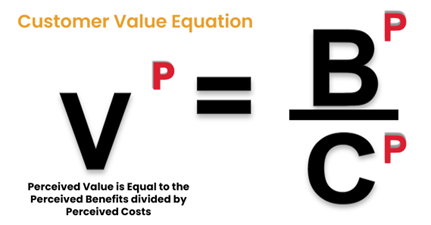As the year of Training and Development comes to an end, it is time that we reflect on another year of change. For today's blog post, I wanted to take a moment to be provocative and use some of the business acumen topics that we teach in our programs to share a few insights about Virtual vs. In-Person training.
The Customer Value Equation
One of the core elements that we teach an Advantexe Business Acumen program is to understand the customer value equation. In the content we teach, this is the foundational concept that all other skills are based on and revolve around.
In the Customer Value Equation, perceived value to the customer is equal to the relationship between the perceived benefits received by the customer relative to the perceived costs the customer pays. In the world of Talent Development, the “customer” is the head of talent development with the budget responsible for training employees to do their jobs and execute the strategy of the business. The talent development team is typically a part of the human resources function which reports to executive leadership at either the corporate or business unit level.

Based on quantitative feedback from customers and participants, I can share the following data which includes survey results from more than 500 participants. When asked about the effectiveness of a recent Business Acumen program, participants shared:
- Live/virtual 12-hour program using simulation and virtual breakout rooms – 92% of participants responded that they will be able to make better business decisions based on enhanced skills as a result of the program.
- Live/in-person 12-hour program using simulation and training room breakout rooms – 86% of participants responded that they will be able to make better business decisions based on enhanced skills as a result of the program.
The primary reasons for the difference in scores were captured by the following quotes:
- “I could see and hear better.”
- “I wasn’t stressed out and exhausted by traveling.”
- “I could still take my kids to school in the morning and learn in the afternoon.”
- “I didn’t have to worry about getting sick.”
- “I was in a safer environment, free from bullying for asking questions”
In terms of the cost, consider the expense for travel, food, lodging, lost time for travel, and the cost of the training:
- Food, travel, and lodging - $1,892 per person for a two-day trip and session
- The opportunity cost of missing work for travel - $300 @ 8 hours of travel = $2400 per person
- Cost of training - $1,360 per person for live and in-person training
The total Cost of Training is $5,652 per person
The costs for the same program (with better scores) being delivered virtually:
- Food, travel, and lodging - $0
- The opportunity cost of missing work for travel - $0
- Cost of training - $600 per person for live virtual training
The total Cost of Training is $600 per person
The True Value
- Value Equation of In-person 87 / 5652 = .015
- Value Equation of Virtual 92/600 = .153
When you do the simple math, the value is 10.22 X for the virtual program than the live program. You read that correctly, the value is 10X for the virtual program.
As you start to plan for next year, you need to ask yourself a serious question, is it worth just a fraction of the true value just so a group of people can have dinner together and network? While networking is great, is that the role of Talent Development?
In the very near future, I think there will be both an expansion of pure virtual, simulation-centric learning for large audiences at scale, and a hybrid of some in-person surrounded by a lot of virtual learning that fits into budgets as well as the work, learning, and life balance.




